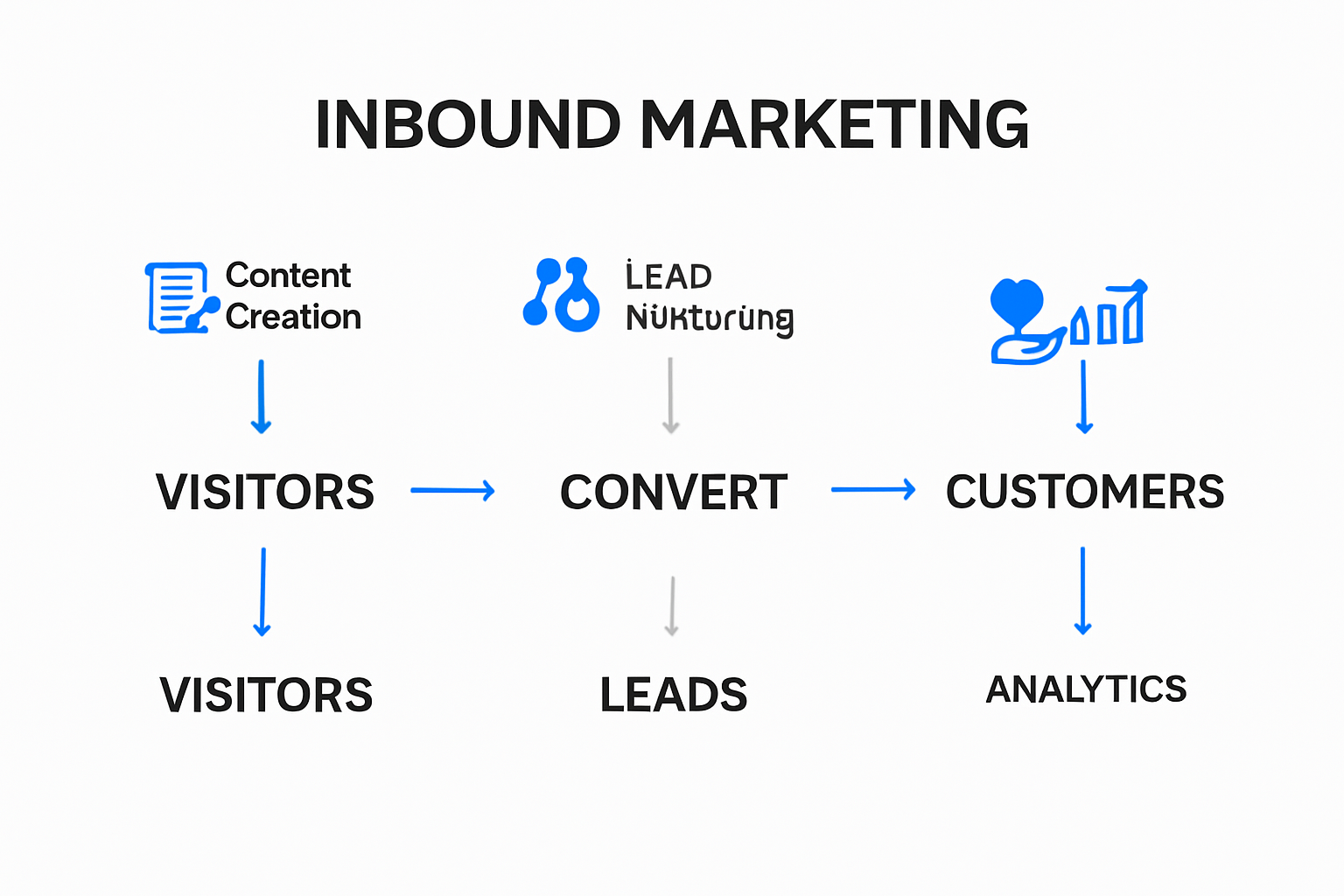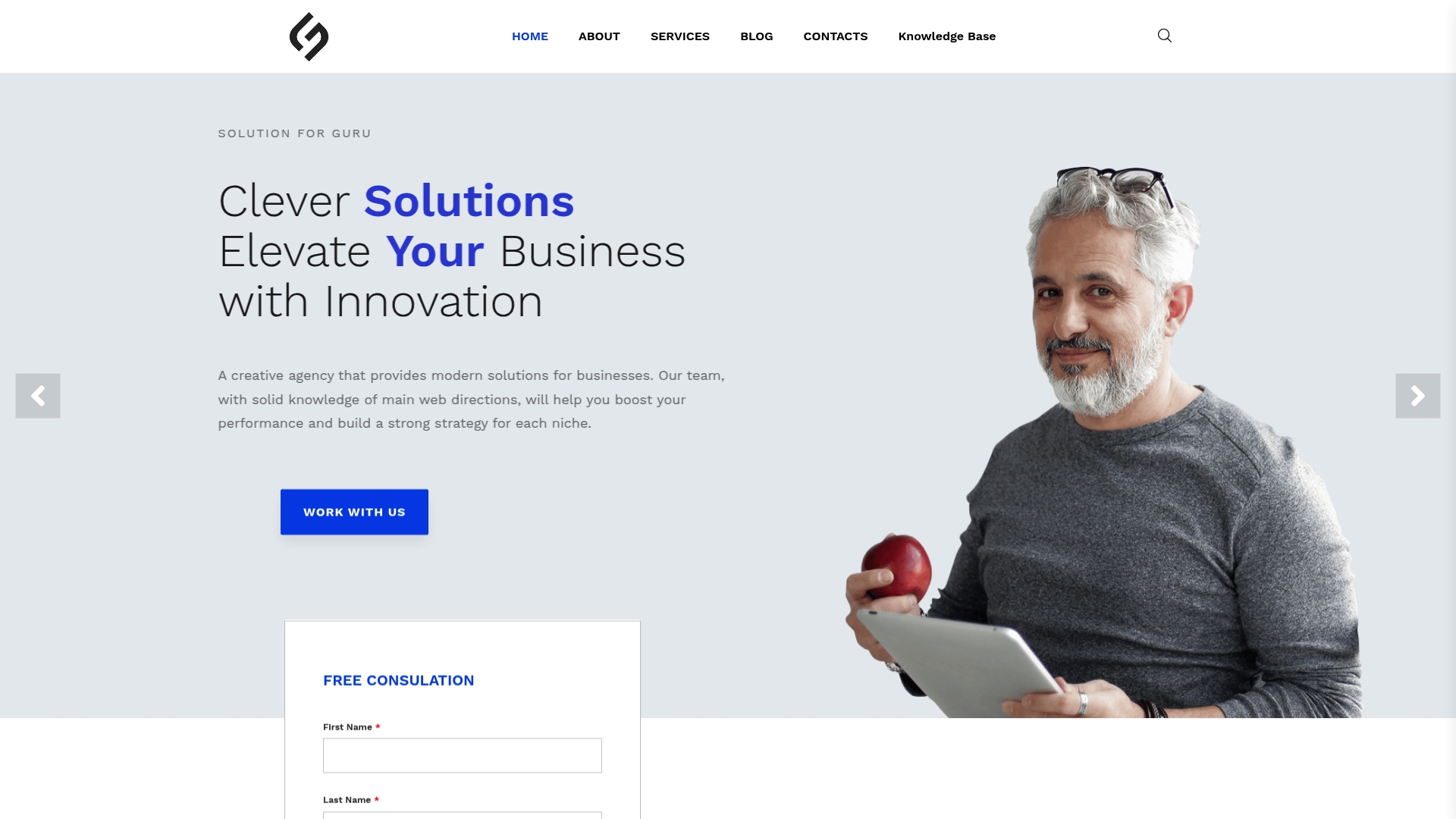What Is Inbound Marketing? A Practical Guide for Businesses

Businesses keep pouring money into old-school ads, hoping for a few extra leads. Turns out, inbound marketing can cut customer acquisition costs by over 60 percent compared to traditional methods. Most assume flashy ads win more sales, but inbound quietly pulls in better leads through smarter, customer-focused content. Get ready to see why attracting with value beats chasing with noise.
Table of Contents
- Understanding What Is Inbound Marketing
- Key Benefits For Modern Businesses
- Core Strategies And Successful Tactics
- Common Challenges And Effective Solutions
Quick Summary
| Takeaway | Explanation |
|---|---|
| Focus on Attracting, Not Interrupting | Inbound marketing draws customers by creating valuable content tailored to their needs, shifting the focus from traditional interruption-based methods. |
| Content is the Cornerstone | High-quality, relevant content is essential for engaging your target audience and establishing your brand as a trusted resource. |
| Leverage SEO for Visibility | Optimizing content for search engines helps potential customers find your business, enhancing organic traffic and lead generation. |
| Continuous Measurement is Key | Regularly track and analyze performance metrics to refine your strategies and improve lead conversion rates. |
| Develop a Customer-Centric Approach | Understanding your customers’ pain points allows you to create targeted, helpful content that builds trust and long-term relationships. |
Understanding What Is Inbound Marketing
Inbound marketing represents a transformative approach to attracting customers by creating valuable content and experiences tailored to their specific needs and interests. Unlike traditional outbound marketing tactics that interrupt potential customers, inbound marketing focuses on pulling people toward your business through meaningful engagement and authentic connection.
To highlight the differences between inbound and traditional outbound marketing approaches, the following comparison table summarizes the key characteristics discussed in this section:
| Approach | Inbound Marketing | Traditional (Outbound) Marketing |
|---|---|---|
| Strategy | Attracts customers with valuable content | Interrupts with ads, cold calls, promotions |
| Audience Engagement | Customer-driven, permission-based | Business-driven, intrusive |
| Content Focus | Educational, helpful, tailored to needs | Generic, sales-focused |
| Trust Building | Builds credibility and relationships | Harder to build trust |
| Cost Efficiency | Cuts acquisition costs (over 60% less) | Typically higher costs |
| Measurement | Easily tracked with analytics tools | Often difficult to measure |
The Core Philosophy of Attracting vs Interrupting
At its heart, inbound marketing flips the traditional marketing script. Learn more about digital marketing strategies that can complement this approach. Traditional marketing often relied on pushing messages at potential customers through cold calls, generic advertisements, and unsolicited communications. In contrast, inbound marketing creates a magnetic pull by developing content that potential customers actively seek out and find valuable.
According to research from ResearchGate, this customer-centric approach fundamentally transforms how businesses build relationships. The methodology centers on understanding customer pain points, interests, and journey stages, then crafting targeted content that addresses those specific needs.

Strategic Components of Inbound Marketing
Inbound marketing operates through several interconnected strategies designed to naturally draw customers closer to your brand. These typically include:
-
Content Creation: Developing high-quality, relevant content that provides genuine value to your target audience. This might include blog posts, videos, podcasts, guides, and other educational resources.
-
Search Engine Optimization (SEO): Ensuring your content is discoverable by optimizing it for search engines, making it easier for potential customers to find you when seeking solutions.
-
Social Media Engagement: Using social platforms to share valuable content, engage with your audience, and build meaningful connections beyond traditional advertising.
The goal is not just to generate leads but to build trust, demonstrate expertise, and create a relationship where potential customers see your brand as a helpful resource rather than an intrusive sales mechanism. By providing solutions and insights before asking for anything in return, businesses can establish credibility and attract more qualified, interested prospects.
Modern consumers have become increasingly sophisticated. They seek information, research thoroughly, and prefer brands that demonstrate understanding and expertise. Inbound marketing meets these expectations by offering transparent, helpful, and personalized interactions that respect the customer’s intelligence and autonomy.
Successful inbound marketing requires a deep understanding of your target audience, consistent high-quality content production, and a commitment to providing genuine value at every stage of the customer journey. It is not a one-time strategy but an ongoing process of listening, learning, and adapting to your audience’s evolving needs and preferences.
Key Benefits for Modern Businesses
Inbound marketing offers a strategic approach that delivers substantial advantages for businesses seeking sustainable growth and meaningful customer connections. By prioritizing customer value and targeted engagement, modern organizations can transform their marketing efforts into powerful relationship-building mechanisms.
Cost-Effective Lead Generation
Traditional marketing methods often require significant financial investments with uncertain returns. Explore strategic business optimization techniques that complement modern marketing strategies. According to Coursera’s comprehensive analysis, inbound marketing generates more qualified leads at a dramatically reduced cost compared to outbound marketing tactics.
Businesses leveraging inbound strategies typically experience a significant reduction in customer acquisition expenses. By creating valuable content that naturally attracts interested prospects, companies can minimize advertising spend while improving lead quality. The Butler Journal of Undergraduate Research found that organizations dedicating resources to inbound marketing strategies demonstrated improved operational performance, highlighting the tangible benefits of this approach.
Enhanced Customer Trust and Engagement
Modern consumers are increasingly sophisticated and resistant to traditional interruption-based marketing. Inbound marketing addresses this challenge by providing genuine value through educational content, expert insights, and solutions tailored to specific customer needs. The Mesa Chamber of Commerce emphasizes that this approach supports long-term growth by building credibility and establishing meaningful connections.
Key engagement advantages include:
- Targeted Content: Developing resources that directly address customer pain points and interests.
- Relationship Building: Creating a foundation of trust through transparent, helpful interactions.
- Personalized Experience: Crafting marketing materials that feel relevant and valuable to individual audience segments.

Measurable and Scalable Marketing Strategy
Unlike traditional marketing methods with nebulous outcomes, inbound marketing provides clear, trackable metrics that enable continuous improvement. Businesses can precisely measure content performance, audience engagement, and conversion rates, allowing for data-driven strategy refinement.
This approach supports scalable growth by:
- Creating a repeatable process for attracting and nurturing leads
- Generating compounding returns through evergreen content
- Allowing flexible adaptation based on real-time audience insights
Implementing an inbound marketing strategy requires commitment to understanding your audience, consistently producing high-quality content, and maintaining an authentic, customer-centric approach. While the initial investment in content creation and strategy development may seem substantial, the long-term benefits of reduced acquisition costs, higher-quality leads, and stronger customer relationships make it a compelling approach for forward-thinking businesses.
Core Strategies and Successful Tactics
Inbound marketing success hinges on a strategic blend of targeted approaches designed to attract, engage, and convert potential customers through valuable, relevant content. By implementing a comprehensive framework of interconnected tactics, businesses can create a powerful marketing ecosystem that naturally draws prospects toward their brand.
Content Creation and Distribution
Explore strategic content management techniques that amplify marketing effectiveness. According to research from the University of Hawaii, content creation represents the cornerstone of successful inbound marketing strategies. This involves developing high-quality, informative resources that directly address your target audience’s specific needs, challenges, and interests.
Effective content strategies typically encompass:
- Blog Posts: Developing in-depth, educational articles that provide genuine value
- Video Content: Creating engaging multimedia resources that explain complex topics
- Podcasts: Producing audio content that offers expert insights and industry perspectives
- Infographics: Designing visually compelling representations of data and information
The key is not just creating content, but ensuring it reaches the right audience through strategic distribution channels. Peer-reviewed research from ResearchGate emphasizes the importance of integrated content distribution across multiple platforms to maximize reach and engagement.
Search Engine Optimization and Lead Nurturing
Search engine optimization (SEO) serves as a critical component of inbound marketing, enabling businesses to increase their online visibility and attract organic traffic. By optimizing content with strategic keywords, creating high-quality backlinks, and ensuring technical website performance, organizations can improve their search engine rankings and draw more potential customers.
Lead nurturing represents another crucial strategy, transforming initial interest into meaningful customer relationships. This involves:
- Segmenting audience groups based on specific characteristics and behaviors
- Developing targeted email marketing campaigns
- Creating personalized content experiences
- Implementing marketing automation tools to streamline communication
Measuring and Optimizing Marketing Performance
Successful inbound marketing requires continuous measurement and refinement. Businesses must leverage advanced analytics tools to track key performance indicators, understand audience behavior, and make data-driven strategy adjustments.
Critical metrics for evaluation include:
- Website traffic volume and sources
- Conversion rates
- Engagement levels across different content types
- Customer acquisition costs
- Return on marketing investment
By adopting a holistic approach that combines strategic content creation, targeted distribution, SEO optimization, and continuous performance analysis, businesses can develop a robust inbound marketing strategy that generates sustainable growth and meaningful customer connections. The most successful organizations view inbound marketing not as a one-time effort, but as an ongoing process of learning, adapting, and refining their approach to meet evolving audience needs.
Common Challenges and Effective Solutions
Inbound marketing, while powerful, presents unique challenges that businesses must navigate strategically to achieve optimal results. Understanding these potential obstacles and developing proactive solutions is crucial for maintaining an effective marketing approach.
To provide an at-a-glance overview, here is a summary table of common inbound marketing challenges and their corresponding solutions as discussed in the article:
| Challenge | Description | Effective Solution |
|---|---|---|
| Consistent Content Production | Maintaining steady flow of high-quality content | Use a comprehensive content calendar |
| Resource Limitations | Limited time or staff for content creation | Invest in content tools & train team members |
| Topic Diversity | Generating varied content for different segments | Develop adaptive content strategies |
| Quality Control | Ensuring content accuracy and engagement | Establish clear editorial guidelines |
| Audience Targeting | Identifying and segmenting the right audience | Implement advanced segmentation & use analytics |
| Engagement Consistency | Maintaining regular, effective audience interaction | Create multi-channel engagement approaches |
| Performance Measurement | Tracking and interpreting marketing results | Invest in analytics platforms & standard reporting |
Content Creation and Quality Management
Explore collaborative strategies for overcoming marketing challenges that impact content development. According to Walden University’s research, developing meaningful consumer relationships remains a significant hurdle in modern marketing strategies.
Content creation challenges typically include:
- Consistent Production: Maintaining a steady stream of high-quality, relevant content
- Resource Limitations: Balancing content creation with other business priorities
- Topic Diversity: Generating varied content that addresses multiple audience segments
- Quality Control: Ensuring content meets high standards of accuracy and engagement
To address these challenges, businesses can implement solutions such as:
- Developing a comprehensive content calendar
- Investing in content creation tools and technologies
- Training team members in effective writing and multimedia production
- Establishing clear editorial guidelines and review processes
Audience Targeting and Engagement
Coursera’s comprehensive analysis highlights the critical importance of building a robust social media presence and collecting customer feedback. Businesses often struggle with precisely identifying and effectively engaging their target audience.
Key engagement challenges include:
- Identifying precise audience segments
- Creating personalized content experiences
- Maintaining consistent audience interaction
- Measuring engagement effectiveness
Effective solutions involve:
- Implementing advanced audience segmentation techniques
- Using data analytics to understand audience behaviors
- Developing adaptive content strategies
- Creating multi-channel engagement approaches
Technical Implementation and Performance Measurement
Technical challenges represent another significant obstacle in inbound marketing. Organizations frequently encounter difficulties in:
- Integrating marketing technologies
- Tracking complex performance metrics
- Aligning marketing and sales efforts
- Demonstrating return on marketing investment
Strategic solutions include:
- Investing in comprehensive marketing analytics platforms
- Developing cross-functional collaboration mechanisms
- Implementing advanced tracking and attribution models
- Creating standardized reporting frameworks
Successful inbound marketing requires a holistic approach that anticipates potential challenges and develops flexible, adaptive strategies. By recognizing common obstacles and proactively implementing robust solutions, businesses can transform potential limitations into opportunities for growth and innovation. The most effective organizations view these challenges not as roadblocks, but as chances to refine their marketing approach and create more meaningful connections with their target audience.
Frequently Asked Questions
What is inbound marketing?
Inbound marketing is a marketing strategy that focuses on attracting customers through valuable content and experiences tailored to their needs, rather than interrupting them with traditional outbound tactics like ads and cold calls.
How does inbound marketing differ from traditional marketing?
Inbound marketing attracts customers by delivering educational and helpful content. In contrast, traditional marketing interrupts potential customers with generic advertisements and promotions, often leading to less engagement and trust.
What are the benefits of using inbound marketing?
Inbound marketing is cost-effective, enhances customer trust and engagement, and provides measurable results. It generates more qualified leads at a lower cost than traditional methods, helping businesses build stronger relationships with their audience.
What strategies are essential for successful inbound marketing?
Key strategies for successful inbound marketing include content creation (like blogs, videos, and infographics), search engine optimization (SEO), social media engagement, and ongoing measurement and optimization of marketing performance.
Ready to Transform Customer Attraction Into Lasting Growth?
Are you finding that traditional marketing just does not deliver the quality leads you want, or maybe your customer engagement feels stale and disconnected? This article highlighted how inbound marketing flips the script by focusing on value-packed content, customer trust, and consistent online visibility. If you are struggling with scattered content, low conversions, or a lack of technology to measure what works, you are not alone. Many business owners feel held back by outdated tools, limited expertise, or the overwhelming speed of change in digital marketing. Boost your brand’s visibility and turn browsers into loyal clients with help from digital professionals who specialize in inbound methods, SEO, web development, and automation solutions.

Get expert guidance and a customized strategy that fits your specific business needs. With Solution4Guru.com, you can tap into powerful digital marketing, advanced web technology, and tailored advice designed to grow your presence and profits. Discover how you can shift from interrupting to attracting clients with a free consultation or review our success stories and service packages on our solutions page. The smartest businesses are making the switch right now. Take the next step and let your inbound journey start here.



